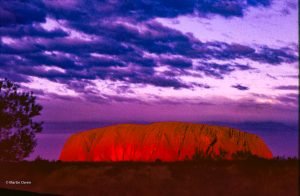Under canvas or on four wheels?

My Researcher in Chief recently sent me an article that got me thinking about two things. Both had roots in my days as tour operator offering travel to Australia and New Zealand to UK based travelers.
The article was from The Washington Post (Click here if you’re so inclined) andwas about Campervans and how they are gaining an increasing following amongst the Millennial generation. It appears that folks are attracted by Volkswagen Microbus conversions that were much loved by the surfers of the ‘60s and ‘70s and that a rental industry has grown up around these and similar small campervans. These are a world away from the RVs (recreational vehicles) that you see rumbling down the Interstate towing a Honda CRV or Jeep Cherokee. These things, much beloved of the newly retired, are built on bus chassis and are HUGE. I guess they’re related to the caravans (trailers) universally hated by UK drivers in that they a) look awful and b)hold up traffic. I’d point out that this opinion Is purely my own heavily biased one and that other, more tolerant opinions are available!
Suffice to say, the RV industry is very large and the owners are high spenders, both in the initial outlay and in their traveling habits. From a tourism point of view, they are a market to be valued and cherished. It’s just not my idea of a good time.
But back to campervans. This was term used in the down-under tourism industry and covered small-ish vehicles that were and are ideal for exploring Australia and New Zealand. We sold countless rentals and they were very popular.
RV rental has been a thing for US tourists for many years with companies like TrekAmerica in the forefront from way back. The smaller campervans are a relatively new option and one that deserves to catch on. The size is much less intimidating to the European driver and that appears to also be the case for the Millennials.
I have to admit that the idea still doesn’t appeal to me, although my younger self may have been tempted ‘back in the day’.
However, the other concept certainly does appeal – Glamping.
My first encounter with Glamping – Luxury Camping to the those not in the know – was in the outback of Australia, near Uluru (Ayers Rock). The amazing monolith of Uluru is in the Red Center of Australia, some five and half hours drive from Alice Spings. It’s about as far from anywhere as you can imagine and one of the major attractions of the area, other than the sunset spectacle of The Rock, is that the outback is unspoiled and ecologically protected by both the indigenous residents and the rest of the country. There are hotels and resorts near Uluru, but their impact on the environment must be limited. Back in the ‘90s the concept of luxury camping was introduced that matched not only the environmental needs but also the idea of a comfortable stay in the outback. Soft Adventure if you like.
Luxury Camping has spread around the world from the Safari experiences in East Africa to the jungle hideaways of Thailand; eco-tents in Patagonia to English refinement in Chewton Glen, Hampshire (UK); Tree houses in Sweden to The Grand Canyon.
The concept is that you can experience the true nature of a destination without severe impact to the environment or indeed, impact to one’s needs for the finer things of life. This isn’t mass tourism. For a start, it’s not cheap. The whole idea is that it’s aimed at those tourists who have an appreciation for both sensitivity to the environment and their own comfort. From that point of view, it’s probably close to the ideal for planned, controlled, sustainable and environmentally aware tourism.
Maybe it’s why it’s been adopted in so many sensitive areas of the world. It’s certainly something that whets my interest!





